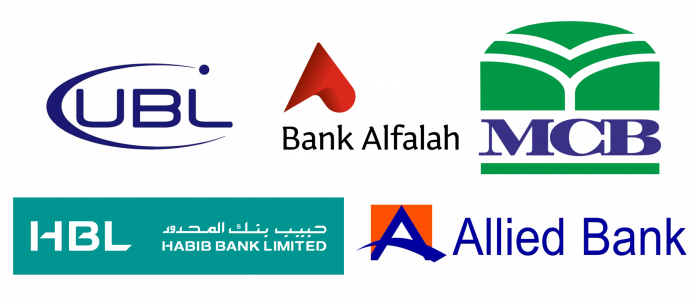When it comes to stock market performance of last year, listed banks’ were at a distant south of benchmark KSE-100 Share Index – a gauge for the market’s overall performance. However, 2016 was not as bad for presidents and chief executive officers (CEOs) of banks, the country’s most powerful group of executives whose paycheques continued to get fatter.
Every bank’s Board of Directors rewarded their chief with a salary increment last year, according to publicly available data. The reports released so far show the average compensation of the CEOs of the top five private banks amounted to Rs 9.4 crore or Rs94 million in 2016.
As of March 3, not all banks had released their annual reports – the state-owned giant and member of the big five, National Bank of Pakistan, and the largest Islamic bank Meezan Bank Limited included – it could, therefore, not be determined as to who received the biggest raise in his paycheque.
However, based on information available so far, Wajahat Husain, President and CEO of United Bank Limited, was clearly on top of the list. As per UBL’s annual report, Husain’s remuneration for 2016 was Rs 14.4 crore, which translates to more than 1 crore per month, courtesy a 13.5% increase over his preceding year’s salary – the highest increase for any CEO based on reports released till the filing of this article.
Husain may continue to be the highest-paid CEO in the banking sector because the second-highest paid banker Atif Bajwa, President and CEO of Bank Alfalah Limited (BAFL), was not even close. Bajwa’s compensation for the year under review increased to Rs9.7 crore or Rs97 million, up 5% from 92.5 million of the preceding year.

Among the top five private banks, Imran Maqbool, President and CEO of MCB, was the third highest-paid CEO followed by Nauman K. Dar of Habib Bank Limited. Maqbool’s salary increased by 5.2% in 2016 to Rs8.9 crore or Rs89 million while Dar’s paycheque swelled 8% to Rs8.1 crore or Rs81 million in 2016.
Though on the lower side among the top-paid bankers, Allied Bank Limited (ABL)’s Tahir Hassan Qureshi received the second-highest salary increment among top five private bank CEOs. The ABL chief’s remuneration increased by 11% to Rs5.8 crore or Rs58.1 million last year.The aforementioned amounts are only compensations and do not include other benefits paid to these bankers. For example, UBL paid another Rs1.4 crore to its CEO under certain short and long term employee benefits during 2016.
When put together, salaries of the top five private bank CEOs increased by an average 9% over the previous year. On the other hand, an average Pakistani witnessed a far lower increase in his annual income during fiscal year (FY) 2016 — according to a report by Express Tribune, the country’s per capita income increased by 2.9% to $1,561 or 1,62,000 (approx.) in FY2016.
Husain, the UBL chief, was the highest-paid executive in Pakistan during 2015, according to reports published in various newspapers and bank CEOs were the top-paid executive group in the country. While many companies – including a few banks – have yet to release their annual reports, 2016 does not seem to be any different when it comes to remuneration of bankers — however, the year was not as good for the banking sector overall, particularly for the shareholders.
According to the data compiled by Insight Securities, the banking sector (all listed banks) posted an average return of 32% (based on market cap) and contributed more than a fifth to the market’s overall growth in 2016, yet they significantly underperformed the benchmark KSE-100 Index, which rallied 46% in the same period.
Market analysts surveyed by Profit attributed this performance to shrinking banking spreads, which remain at their lowest level in over a decade and central bank’s policy rate that hovers at its lowest level of last 42 years.
A bank spread is the difference between borrowing rate (how much banks pay to depositors) and lending rate (how much banks charge from borrowers). In other words, it is banks’ equivalent of profit margin thus the higher the spread, the more a bank earns.
Banks profits either remained flat or declined slightly last year, Umair Naseer of Topline Securities said. This was mainly because of Pakistan Investment Bonds, which reached maturity in mid-2016 requiring most banks to reinvest the amount gained from it on lower interest rates.
Explaining, the analyst said banks invested a major chunk, about 30% or Rs1.2 trillion (amount for entire sector), of their deposits into PIBs, for it is less riskier, if risky at all, compared to lending to the private sector. When banks invested in PIBs three years ago, the rates were much higher (12% for three-year PIB), he said. When these bonds matured in mid-2016, the banks had to reinvest the money in new PIBs at a much lower rate (6.38% for three-year bond), which ate up their profit margins, he added.
Most analysts we spoke to are convinced 2016 wasn’t a good year for banking sector, but they also add the previous year (2015) was better. Banks’ profits grew by more than 10% in 2015, which also explains the raises earned by banks CEOs the next year (2016), says Rohit Kumar of Insight Securities. That is the raises given in 2016 reflect the performance of 2015, he added.

However, analysts also say raises given to the CEOs should not be judged based on profits alone. All banks have internal targets and any bonuses or rewards given to them may be a factor of achieving those targets. In short, the data released by banks indicate their performance in the year under review but the compensation of their CEOs is reflective of their performance in the preceding year, they say.
Going by that standard, Husain looks all set for another handsome raise because UBL boosted its net profit by 7.8% to Rs27.7 billion and gave a total shareholder return of 66% in 2016 (according to Insight Securities). This is the highest return by any bank in the listed sector, outperforming the market by 20% in a year when banking sector’s overall profitability remained almost flat.
However, UBL is not the only bank, which outperformed the benchmark KSE-100 Index: Meezan Bank, NBP, and BAFL posted 59%, 58%, and 53% return respectively in the same year while HBL remained in line with the market, recording 46% total return for the year.
























